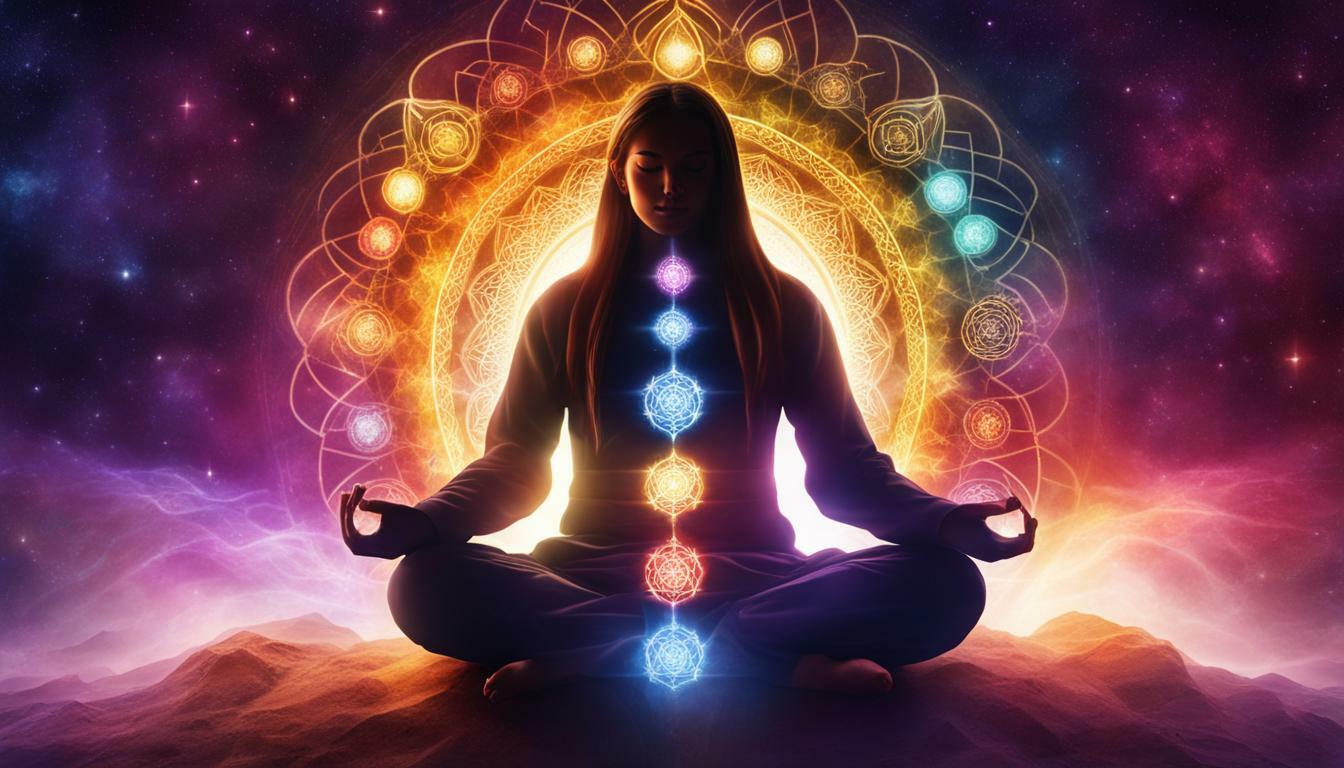Kundalini meditation is a powerful technique that can awaken your spiritual energy and bring a sense of peace within yourself. This practice aims to activate the dormant energy located at the base of the spine and stimulate its upward movement through the body’s seven chakras. By doing so, Kundalini meditation helps establish a connection between the mind and body, leading to mental, physical, and spiritual well-being.
Key Takeaways:
- Kundalini meditation is a technique that seeks to awaken the dormant energy at the base of the spine and move it through the body’s seven chakras.
- It is not a set of beliefs or a religion but a practice that helps clear the mind and access the inner self.
- To practice Kundalini meditation, find a quiet space, sit comfortably with a straight spine, and close your eyes.
- Focus on your breath and chant a mantra, such as “sat nam,” to help focus the mind.
- Gradually slow down your breathing and maintain the cycle of breath and mantra throughout the meditation.
Kundalini meditation offers a range of benefits, including improved concentration, increased creative energy, enhanced mind-body connection, reduced anxiety and stress, improved cognitive functioning, and better sleep. It can be practiced at any time, but it is advisable to avoid meditating right after a meal. Start with shorter meditation sessions and gradually increase the duration as you become more comfortable. Remember, Kundalini meditation is a personal practice that does not require any specific beliefs or religion; it is a technique for self-discovery and self-improvement.
Understanding Kundalini Energy and Chakras
Before diving into the practice of Kundalini meditation, it’s important to understand the concept of Kundalini energy and how it relates to the chakras in your body. Kundalini energy is believed to be a dormant force that resides at the base of the spine, often represented as a coiled serpent. Through meditation, this energy can be awakened and guided through the body’s seven chakras, which are energy centers running along the spine.
The chakras are like wheels or vortexes that spin and regulate the flow of energy in the body. Each chakra corresponds to different aspects of our physical, emotional, and spiritual well-being. When the Kundalini energy rises and passes through each chakra, it helps to balance and harmonize these aspects, promoting a sense of overall well-being.
Here is a breakdown of the seven chakras and their associated qualities:
| Chakra | Location | Qualities |
|---|---|---|
| Root (Muladhara) | Base of the spine | Stability, survival, grounding |
| Sacral (Svadhishthana) | Lower abdomen | Creativity, sexuality, emotions |
| Solar Plexus (Manipura) | Upper abdomen | Personal power, confidence, self-esteem |
| Heart (Anahata) | Center of the chest | Love, compassion, connection |
| Throat (Vishuddha) | Throat area | Communication, self-expression |
| Third Eye (Ajna) | Between the eyebrows | Intuition, clarity, insight |
| Crown (Sahasrara) | Top of the head | Spirituality, higher consciousness |
By awakening and balancing these chakras, Kundalini meditation can help us tap into our full potential and experience greater well-being on all levels. As we progress in our Kundalini meditation practice, we may explore more advanced techniques that focus on specific chakras or combine breathwork, meditation, and movement to further enhance the flow of Kundalini energy.
Setting Up Your Meditation Space
Creating a serene and distraction-free environment is crucial when it comes to practicing Kundalini meditation. The right meditation space can greatly enhance your experience and help you achieve a deeper state of relaxation and focus. Here are some tips on how to set up your meditation space:
- Choose a quiet location: Find a spot in your home where you can have some privacy and minimize external noises. This will allow you to fully immerse yourself in the meditation practice without any interruptions.
- Clear the clutter: Declutter the area and remove any unnecessary objects that may distract you. Keeping your meditation space clean and organized can help create a sense of calm and tranquility.
- Create a comfortable sitting position: Choose a cushion or mat that provides adequate support for your body. You can sit cross-legged on the floor or use a meditation chair if that feels more comfortable for you. The idea is to find a position that allows you to sit with a straight spine and relaxed posture.
- Set the mood: Consider using soft lighting, candles, or incense to create a peaceful ambiance. Some people find that playing gentle instrumental music or nature sounds can also enhance the meditative experience.
By following these simple steps, you can create a meditation space that is conducive to deep relaxation and introspection. Remember, your meditation space is a sacred sanctuary where you can connect with your inner self and cultivate a sense of inner peace.
| Benefits of a Well-Designed Meditation Space: |
|---|
| Reduced distractions and increased focus |
| Enhanced relaxation and stress relief |
| Improved mental clarity and concentration |
| Greater sense of calm and well-being |
Having a dedicated meditation space can also help you establish a consistent meditation routine. When you have a designated area for your practice, it becomes easier to incorporate Kundalini meditation into your daily life. So, take the time to create a space that resonates with you and supports your journey towards self-discovery and personal growth.
Getting Started with Kundalini Meditation
Now that you have your meditation space set up, let’s dive into the actual practice of Kundalini meditation. This ancient technique aims to awaken the dormant energy at the base of your spine and move it through your body’s seven chakras, promoting mental, physical, and spiritual well-being. Remember, Kundalini meditation is not a set of beliefs or a religion, but rather a powerful tool for clearing the mind and accessing your inner self.
To begin your Kundalini meditation practice, find a quiet and distraction-free space where you can sit comfortably with a straight spine. Close your eyes and start by focusing on your breath. Take slow, deep breaths and let your mind settle into the present moment. As you continue to breathe, you can introduce a mantra into your practice. One commonly used mantra is “sat nam,” which means “truth is my identity” in Sanskrit. Chanting this mantra silently or aloud can help bring focus to your mind and deepen your meditation experience.
As you settle into the rhythm of your breath and mantra, gradually slow down your breathing. Allow your breath to become deep, smooth, and effortless. With each inhalation, envision the healing energy rising from the base of your spine and flowing through each chakra, revitalizing and balancing your entire being. With each exhalation, release any stress, tension, or negative emotions that you may be holding onto.
Continue this cycle of breath and mantra for your desired meditation duration. Start with just a few minutes and gradually increase the length of your practice as you become more comfortable. Remember, consistency is key when it comes to reaping the benefits of Kundalini meditation. By making it a regular part of your daily routine, you can experience improvements in concentration, increased creative energy, enhanced mind-body connection, reduced anxiety and stress, improved cognitive functioning, and better sleep.
| Benefits of Kundalini Meditation |
|---|
| Improved concentration |
| Increased creative energy |
| Enhanced mind-body connection |
| Reduced anxiety and stress |
| Improved cognitive functioning |
| Better sleep |
Remember, Kundalini meditation is a personal practice that does not require any specific beliefs or religious affiliations. It is a technique for self-discovery and self-improvement, allowing you to tap into your inner wisdom and unlock your full potential.
The Benefits of Kundalini Meditation
Kundalini meditation offers numerous benefits for both the mind and body. By awakening the dormant energy within you and aligning it with the body’s seven chakras, this practice can help create a harmonious connection between your physical, mental, and spiritual well-being.
One of the key benefits of Kundalini meditation is improved concentration. By quieting the mind and focusing on your breath and mantra, you can train your mind to stay focused and present. This enhanced concentration can have a positive impact on your daily life, allowing you to better handle challenges and tasks with clarity and efficiency.
Another benefit of Kundalini meditation is increased creative energy. As you tap into your inner self and connect with the universal energy, you may find yourself unlocking new levels of creativity and inspiration. This can be invaluable for artists, writers, and anyone seeking to bring forth their unique ideas and talents.
Additionally, Kundalini meditation helps strengthen the mind-body connection. By practicing this form of meditation, you can become more attuned to the subtle sensations and energy within your body. This heightened awareness can lead to a greater sense of overall well-being, as you learn to listen to the needs of your body and respond accordingly.
| Kundalini Meditation Benefits: |
|---|
| Improved concentration |
| Increased creative energy |
| Enhanced mind-body connection |
Reduce anxiety and stress
Another significant benefit of Kundalini meditation is its ability to reduce anxiety and stress. By practicing this meditation technique, you can activate the relaxation response in your body, leading to a sense of calm and inner peace. This can be particularly beneficial for individuals who experience high levels of stress or struggle with anxiety disorders.
Kundalini meditation allows you to tap into the vast potential within you and unlock a state of deep relaxation and tranquility. It is a powerful tool for self-discovery and self-improvement.
Moreover, Kundalini meditation has been found to improve cognitive functioning. Regular practice can enhance mental clarity, memory, and focus. It can also aid in the management of conditions such as ADHD and age-related cognitive decline.
Lastly, Kundalini meditation can promote better sleep. By establishing a calming and meditative routine before bedtime, you can prepare your mind and body for a restful night’s sleep. This can be particularly beneficial for individuals struggling with insomnia or sleep disorders.
Overall, practicing Kundalini meditation offers a multitude of benefits for the mind and body. Improved concentration, increased creative energy, enhanced mind-body connection, reduced anxiety and stress, improved cognitive functioning, and better sleep are just a few of the positive outcomes that can be achieved through this powerful technique. Whether you are a beginner or an advanced meditator, Kundalini meditation provides a pathway to self-discovery, self-improvement, and a deeper connection with your inner self.Incorporating Kundalini Meditation into Your Daily Routine
Consistency is key when it comes to experiencing the full benefits of Kundalini meditation. By making it a regular part of your daily routine, you can deepen your practice and cultivate a sense of peace and wellbeing. Here are some tips to help you incorporate Kundalini meditation into your daily life:
- Choose a specific time: Find a time of day that works best for you and commit to practicing Kundalini meditation at that time every day. Whether it’s early morning, during your lunch break, or before bedtime, consistency is important.
- Create a dedicated space: Set up a quiet and peaceful space where you can practice without distractions. It could be a corner of your room or a special meditation area. Make it comfortable and inviting.
- Start with shorter sessions: When you are just beginning, aim for shorter meditation sessions, such as 10-15 minutes. As you become more comfortable and experienced, gradually increase the duration.
- Use reminders: Set reminders on your phone or place visual cues in your environment to remind you to practice Kundalini meditation. This can help you stay consistent and make it a habit.
- Combine it with other activities: If you struggle to find dedicated time for meditation, try incorporating it into your daily activities. For example, you can practice mindfulness while walking, doing chores, or even during your commute.
Remember, the benefits of Kundalini meditation are cumulative, so even a few minutes of practice each day can make a difference. Embrace the process and be patient with yourself. With time and dedication, you will experience the transformative effects of this powerful practice.
Table: Incoporating Kundalini Meditation
| Tip | Description |
|---|---|
| Choose a specific time | Find a consistent time of day to practice Kundalini meditation. |
| Create a dedicated space | Set up a quiet and peaceful area for your meditation practice. |
| Start with shorter sessions | Begin with shorter meditation sessions and gradually increase the duration over time. |
| Use reminders | Set reminders or visual cues to help you remember to meditate. |
| Combine it with other activities | Integrate Kundalini meditation into your daily activities to make it more accessible. |
Exploring Advanced Kundalini Meditation Techniques
Once you’ve established a regular Kundalini meditation practice, you may be interested in exploring more advanced techniques and variations. These techniques can further deepen your experience and open up new avenues of self-discovery and spiritual growth. Here are some advanced Kundalini meditation techniques that you can incorporate into your practice:
1. Kundalini Pranayama
Kundalini pranayama involves specific breathing exercises that help to activate and channelize the Kundalini energy. One such technique is Breath of Fire, which involves rapid and rhythmic breathing through the nose. This technique can generate heat and energy in the body, intensifying the Kundalini experience.
2. Kundalini Mudras
Mudras are hand gestures that help to direct and enhance the flow of energy within the body. In Kundalini meditation, specific mudras can be used to stimulate specific chakras or to focus the energy in a particular area. For example, Gyan Mudra, where the index finger and thumb touch, is commonly used to enhance concentration and clarity.
3. Kundalini Mantras
Mantras are sacred sounds or words that help to create a specific vibrational frequency within the body. Chanting Kundalini mantras can help to deepen the meditation experience and connect with the divine energy. The mantra “Sat Nam,” meaning “truth is my identity,” is often used in Kundalini meditation to align with the true self and awaken inner consciousness.
Remember, as you explore advanced Kundalini meditation techniques, it’s essential to approach them with an open mind and a sense of curiosity. Take your time to learn and practice each technique, allowing yourself to fully experience the effects. It’s also important to listen to your body and honor its limitations. Kundalini meditation is a personal journey, and each individual may have a unique experience. Embrace the exploration and enjoy the transformative power of Kundalini meditation.
| Technique | Description |
|---|---|
| Kundalini Pranayama | Specific breathing exercises to activate and channelize Kundalini energy. |
| Kundalini Mudras | Hand gestures to direct and enhance the flow of energy within the body. |
| Kundalini Mantras | Sacred sounds or words to create a vibrational frequency and connect with divine energy. |
Conclusion
Kundalini meditation is a powerful practice that can bring about profound positive changes in your life. By awakening the dormant energy within you and channeling it through the body’s seven chakras, Kundalini meditation helps to create a deeper connection between your mind and body.
This technique, which is not tied to any specific beliefs or religion, offers a pathway to clear the mind and access your inner self. Through finding a quiet, distraction-free space and adopting a comfortable sitting position, you can begin your journey of self-discovery through Kundalini meditation.
By focusing on your breath and chanting a mantra, such as “sat nam,” you can quiet the mind and allow the energy to flow freely. As you gradually slow down your breathing and continue the cycle of breath and mantra, you will experience the numerous benefits of Kundalini meditation.
Improved concentration, increased creative energy, enhanced mind-body connection, reduced anxiety and stress, improved cognitive functioning, and better sleep are just some of the benefits that await you on this transformative path. Remember to start small and increase the length of your meditation practice over time.
So why wait? Start exploring Kundalini meditation today and experience the profound positive changes it can bring to your life. Whether you’re a beginner or seeking to expand your practice, the benefits of Kundalini meditation are within your reach.
Are Body Scan and Kundalini Meditation Similar in Practice?
Body scan meditation practice and Kundalini meditation may differ in their approach, but both share common goals. While body scan meditation focuses on consciously scanning the body and bringing awareness to each part, Kundalini meditation works with the dormant energy at the base of the spine, aiming to awaken and elevate it. Despite their distinct methods, both practices aim to enhance self-awareness and promote a deeper connection with the body and mind.
FAQ
Q: What is Kundalini meditation?
A: Kundalini meditation is a practice that aims to awaken the dormant energy at the base of the spine and move it through the body’s seven chakras. It is not a set of beliefs or a religion but a technique that helps clear the mind and access the inner self.
Q: How do I practice Kundalini meditation?
A: To practice Kundalini meditation, find a quiet, distraction-free space, sit comfortably with a straight spine, close your eyes, and focus on your breath. Chanting a mantra, such as “sat nam,” can help focus the mind. Gradually slow down your breathing and continue the cycle of breath and mantra throughout the meditation.
Q: What are the benefits of Kundalini meditation?
A: Kundalini meditation can have a variety of benefits, including improved concentration, increased creative energy, enhanced mind-body connection, reduced anxiety and stress, improved cognitive functioning, and better sleep.
Q: When should I practice Kundalini meditation?
A: Kundalini meditation can be practiced at any time, but it is recommended to avoid meditating after a big meal. It is important to start small and gradually increase the length of time you meditate.
Q: Do I need any specific beliefs or religion to practice Kundalini meditation?
A: No, Kundalini meditation is a personal practice and does not require any specific beliefs or religion. It is a technique for self-discovery and self-improvement.








